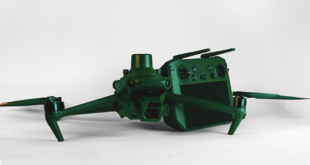Drones have flown into India’s fields pretty fast. It was only in August 2021 that the ministry of civil aviation liberalised the drone use policy, allowing certain types of drones to fly without prior permission. Soon after, the Department of Agriculture and Farmers’ Welfare published the standard operating procedure (SOP) for the use of drones in spraying pesticides in agricultural, forestry and non-cropped areas.
Last month, the department amended its policy to include drone subsidy proposals — so that Farmers Producers Organisations (FPOs), for instance, can receive a grant of up to 75% of the cost of an agriculture drone. Then in her budget speech, the FM said kisan drones will be used for crop assessment, digitisation of land records and spraying of insecticides and nutrients. The government is offering a helping hand – one, with a small budget to experiment with drones and, two, by dumping some restrictions to ensure the ease of flying them.
The government is pushing for a massive use of drones in agriculture across India. It wants drones to be yet another agricultural equipment like power tillers, manure spreaders, trolley pumps, sprayer pumps, et al. But who will pay for the drone service? Will end users, meaning farmers, have to bear the entire cost? Or, will the government chip in?
Ramesh Chand, a member of the government think tank NITI Aayog, argues that drone services will be costly only in the initial years. “Over time, it will be cheaper than human labour because of the sheer economies of scale,” says Chand, an agricultural scientist who has been lobbying for years to make kisan drone a reality. “Let us give this new application a chance. Suppose a group of farmers decides to hire a drone for one cluster, then the cost per farmer will come down. Also, we have to factor in the cost of human health in manual spraying versus spraying by drones,” he adds.
The department of agriculture estimates that the service of a drone that has the capacity to carry a 10 kg payload will cost Rs 350-450 per acre. The calculation is based on the assumption that a drone equipped with multiple batteries will be utilised for at least six hours a day, covering about 30 acres of farmland. The cost of operation could vary, depending on the type of crop and topography.
According to the database of the Directorate General of Civil Aviation (DGCA), as many as 558 drones had a unique identification number as on February 9. The model number, weight and category of each drone are noted. The categories include nano (up to 250 gram), micro (up to 2 kg) and small (2-25 kg). There are 22 registered drone manufactures and importers in India, according to the database. Models such as Omni Agri 01 (2 kg) and Agribot UAV (23 kg) are mainly used for agriculture.
According to the government’s SOP, only agriculture drones approved by the DGCA are permitted to fly. The pilots, who operate the drones, have to be DGCA-certified too. Agriculture drones with a 10 kg payload are considered most suitable for spraying from a height of 1-3 m over the crop canopy, according to an official in the department. The agri-drone SOP also adds that the pilot must not consume alcohol for eight hours prior to flying, and that it must not fly over a gathering of people or private properties without permission.
Delhi-based company Matrix Geo Solutions, which has 15 drones, has been providing services since 2014. Its cofounder Amit Sharma says, so far, only two of its trips have been connected to agriculture — for an assessment of sugarcane crop in UP and to fight the locust attack of 2020. He says it makes economic sense for a drone company to visit a farm, provided it gets an order for Rs 12,000-15,000 a day.
On Wednesday, India banned the import of foreign drones except those used for research and development, defence and security, according to a notification issued by the Directorate General of Foreign Trade (DGFT). Import of drone components is exempted because made-in-India drones still rely heavily on China for them, thereby minimising its fallout on the government’s ambitious plan to roll out agri-drones.
In the DGCA database, Indian manufacturers and importers of drones are clubbed together. Out of 22 entities, Gurgaon-based IoTechWorld Avigation, for example, manufactures Agribot, a hexacopter used for spraying in farms. Mumbai-based IdeaForge, meanwhile, has a variety of products for survey, mapping and surveillance. According to industry sources, a made-in-India agriculture drone for spraying costs about Rs 4-5 lakh.
The imported ones are 25% cheaper. India has hundreds of thousands of drones, most of them imported from China, with Shenzhen-headquartered DJI having the largest market share. Only some of these drones are registered with the DGCA.
The latest measures indicate that GoI wants to discourage Indian companies from buying drones from China even as it ensures that the manufacturing of drones in India does not get affected by the lack of components from the neighbouring country.
MADE IN INDIA
Ashutosh Sharma, former secretary in the Department of Science and Technology (DST) and professor at IIT-Kanpur, says that once the sector opens up, the price of Indian drones will fall drastically. “Once there is demand, more and more Indian companies will manufacture drones. Indian drones will be cheaper than imported ones. Drone-making is a simple technology,” he says.
SK Pattanayak, former Union agriculture secretary, says kisan drones will have three functions to begin with. “First, drones will be used for crop assessment. That will help in early settlement of insurance claims. Second, it will be deployed for the digitisation of land records. For both these tasks, the government will pay for the services. The third function is spraying, for which farmers will pay,” he says, adding that in future the device could be used for monitoring the moisture content in crops as well as for controlling epidemics.
The DST had earlier experimented with a pilot project by using drones with hyper spectral sensors to receive information on the health of soil and crops, water content, nutrients, et al. Sharma bets on the proliferation of drones in the hinterland, saying the phenomenon will be comparable to STD booths of another era. “If a farmer gains by using a drone, she will be willing to pay for it. To my mind, drone services in rural areas will be like STD booths of yesteryear. It will stimulate entrepreneurship. Farmers won’t own drones, they will hire them,” he says.
Sonmoni Borah, joint secretary in the Union department of land resources, says drones are already being used as one of the many land surveying methods.
“We use a differential global positioning system, high resolution satellite imagery and a variety of technologies such as LiDAR (for topographic surveying), CORS (continuously operating reference stations), aerial mapping, hybrid methodology as well as drones. The use of drones along with photogrammetry image processing is gaining popularity now,” he says.
Agri-exporters could also deploy drones for quality control. Automation will help control the level of pesticide being sprayed, thus reducing residue, a critical requirement for exports to the US or European Union. M Angamuthu, chairman of the Agricultural and Processed Food Products Export Development Authority (APEDA), says, “Usage of drones will benefit agricultural exports where quality is key. There are instances where our products get rejected because of residue problems. If drones are used in spraying pesticides, there will be better quality control.”
Precision agriculture is an emerging trend in farm management globally, and India cannot afford to be an outlier. World population is expected to grow from 7.7 billion in 2020 to 8.5 billion in 2030, according to OECD-FAO Agricultural Outlook 2021-2030. This means the world will need more food. In India, 5 million tonnes of food grain have to be added to the national food basket every year for the next decade to feed its growing population, according to the agriculture department’s estimate. India’s total food grain production was 275 MT in 2017-18, says the department’s latest annual report.
Since the total area of cultivation in India has remained constant for decades, improving soil nutrients is critical for high productivity. Precision agriculture through GPSbased drone technology is expected to play a pivotal role here.
Kisan drones could be a disrupter in India’s traditional agri-industry. It can make farming more intelligent, precise and productive.
Over time, drone services will be cheaper than human labour: Ramesh Chand, member, NITI Aayog
Ramesh Chand, member of NITI Aayog, says the cost of drone services will come down when demand increases and that the agriculture drone market will grow exponentially in India. Edited excerpts from an interview with ET:
What’s the rationale behind the government’s recent push for agriculture drones?
Use of drones in agriculture will have many benefits. First, it will achieve the goal of precision farming (information technology-based farm management). It will improve efficiency, reduce cost and promote quality. Manual spraying of pesticides, for example, leads to uneven distribution whereas drones do it precisely. An advanced drone will be able to control the spray as it will automatically leave out areas where crops are not infected by any disease. Second, spraying pesticides using drones will minimise hazards on human health.
Use of drones will be more helpful for tall crops such as sugarcane. In the future, the functioning of drones will keep expanding. It can be used for planting seeds too. NITI Aayog has been pushing for drones in agriculture for some time now. Earlier, a lot of permissions were required to fly a drone. If a drone completed one spray, it again needed permission for the second flight. Now such provisions have been discarded.
Will farmers be able to pay for such a costly service?
Drone services are costly initially. Over time it will be cheaper than human labour because of the sheer economies of scale. Let us give this new application a chance. Suppose a group of farmers hires a drone for one cluster, cost per farmer will come down. Also, we will have to factor in the cost of human health in manual spraying versus spraying by drones.
Don’t you think farmers with larger landholdings will use it more?
To my mind, it will be scale neutral. When it is not economical for a small farmer to buy a tractor, he hires one. Farmers will hire drones as well. Several agri-tech companies will come forward and act as agencies to offer drone services. Small landholders will benefit from it. Once the demand increases, thousands of drones will be manufactured in a matter of a few weeks. Cost of drones will reduce then. Agriculture drone market in India will grow exponentially.
 Unmanned Aerial Vehicle The latest drone news
Unmanned Aerial Vehicle The latest drone news



